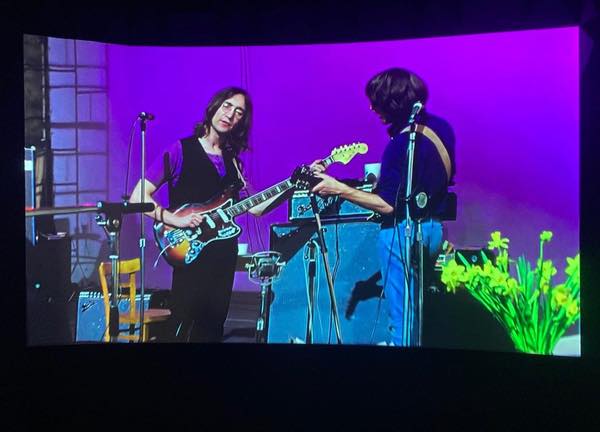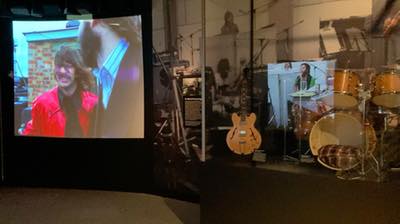
One of the murkiest and most misunderstood chapters of the Beatles’ multi-faceted legacy comes into clearer focus with the Rock Hall’s new exhibition on view now through the end of 2022. Featuring dazzlingly restored film sequences of impactful footage largely unseen for 50 years, the installation portrays in intimate detail something that, for many Beatles fans, would be the dream of a lifetime — the chance to observe them in the process of crafting their timeless and influential music together.
The title itself — Get Back to Let It Be — outlines the essential framework of the narrative. What began as an attempt by the Beatles to get back to their roots as a simple rock band led to a long and winding road that would ultimately result in their Let It Be album and theatrical movie a year and a half later. This exhibition zooms in on the very beginning of the story, the tumultuous events of January 1969.
During the previous five years they’d recorded nine earth-shattering albums, and toured the world incessantly for three of those years. They needed a rest, but the world demanded much from them, and there was no template for this level of success. So barely a month after releasing their double album masterpiece The Beatles, they agreed to be filmed at work in the recording studio for a television special.
This phase of their career was fraught with false starts, dead ends, mistrust, rash decisions and erratic behavior. And yet, despite the firestorms that overtook their personal and business affairs, these men were at heart consummate professionals and best friends. When it was time to make music, they were secure, relentlessly creative individuals who shared bonds with each other that no one else could touch. To witness these scenes is to rest inside the eye of the Beatles hurricane.
Revelations abound. Sidelong glances or casual nods might fill books with their implications. Offhand remarks and clever jibes seem to carry hidden meanings. See them playing instruments that never appeared with them on stage. Watch Billy Preston light up the sessions with good vibes. Observe Linda Eastman and Yoko Ono chatting intimately in the middle of the room, with commotion and music all around them.

The scenes are projected onto large screens nestled inside cozy pod-like viewing areas, so it’s easy to feel as though you’re the only observer present. Each of three rooms plays a different five-minute film of the recording sessions as they unfolded in two London studios. Five minutes doesn’t sound like much time, but each segment is so rich with detail and reference that many fans will stay and watch them repeatedly. Finally, a fourth, even larger screen reveals the conclusion of this little episode of Beatle history — the exhilarating rooftop concert played for an unsuspecting lunchtime crowd in midwinter London.
The exhibition wisely steers clear of the countless unanswered questions, loose threads and fantastical tangents that emanate from this slice of the Beatles legend. Scholars, historians and fans will likely never get to the bottom of it all. Instead, the installation offers a narrow but very deep glimpse of the inner sanctum of creativity we call the Beatles.
Ancillary exhibits here are spare, but choice. You can see John’s Epiphone Casino guitar, the maple Ludwig Hollywood drum kit Ringo used for the first time at these famous sessions, clothing worn by the band, handwritten lyrics and even a copy of the dissolution contract that finally set the terms for the Beatles’ ultimate breakup. If you crave more relics, you can round the corner and see other Beatle items in the museum’s permanent gallery, including guitars, Lennon’s Mellotron keyboard and more.
Get Back to Let It Be is presented as a companion to the three-part documentary series The Beatles: Get Back, now streaming on Disney Plus and available on DVD. The film clips shown here were custom edited for the Rock Hall by director Peter Jackson’s team. They were culled from the original 60-hour motherlode of 16mm films and 150 hours of audio tapes from 1969.
Whether or not you crave the full seven-hours-plus of the home release, you’ll never get to experience it this close, on screens so large and vivid. This is imagery that true believers have been salivating to see for more than 50 years. It succeeds in transporting the viewer to a fabled time and place where four or five magicians conjured their music and changed the world.

Jordan Davis saw the Beatles perform live in 1964, and is still processing the experience. Hear his radio show, Mise-en-Scène, Tuesdays 9-11am on WRUW 91.1FM.